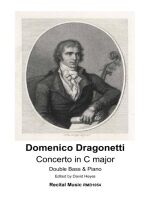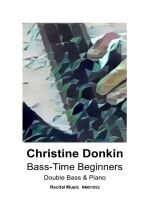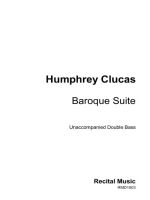Kol Nidrei

Product code:
£8.50
Description
The solo cello repertoire has been plundered mercilessly by double bassists over the years, creating a catalogue of transcriptions of which many, dare I say, sound just as good when played on the double bass. Max Bruch’s Kol Nidrei is one such work which transcribes beautifully for the instrument with the rich, powerful and sonorous elements of the double bass adding to the drama, sincerity and pathos of this great work.
German composer-conductor Max Bruch (1838-1920) was born in Cologne and was a prolific composer, writing in many genres, but today is remembered primarily for his Violin Concerto No.1 in G minor and Kol Nidrei Op.47 for cello and orchestra or piano. Completed in Liverpool in 1880 but conceived during his stay in Berlin, where Bruch was conductor of the Liverpool Philharmonic Society from 1880-83 (now the Royal Liverpool Philharmonic Orchestra) Kol Nidrei was published a year later in Berlin by N.Simrock. It was composed for and dedicated to German cellist Robert Hausmann (1852-1909), who also premiered several works by Johannes Brahms, who had long wanted to commission a work from Bruch to match the success of his violin concertos and he was able to help the composer with some technical aspects of the piece. Bruch wrote to his publisher from Liverpool “I have written a cello work with orchestra for Hausmann, on the finest Hebrew melody, “Kol Nidrei” (Adagio). I shall hear it for the first time here on 2 November with Hollmann, and can send it to you immediately…[Hausmann] has plagued me for so long, until at last I wrote this work. It also sounds very well as a violin piece; I have already arranged it and tried it out with Schiever, and everyone says it works well.”
Bruch seems to have had no problems with arranging it for different instruments including viola and piano, piano and harmonium, solo piano, cello and organ and solo organ, so it’s unlikely he would have had no problems with the arrangement for double bass.
In a letter to Emil Kamphausen, Bruch described how he came upon the material for the work: “The two melodies are first-class – the first is an age-old Hebrew song of atonement, the second (D major) is the middle section of a moving and truly magnificent song ‘O weep for those that wept on Babel’s stream’ (Byron), equally very old. I got to know both melodies in Berlin, where I had much to do with the children of Israel in the Choral Society…” In 1889 Bruch wrote in a letter to cantor and musicologist Eduard Birnbaum that he had been introduced to the Kol Nidrei by the Lichtenstein family of Berlin, adding, “Even though I am a Protestant, as an artist I deeply felt the outstanding beauty of these melodies and therefore I gladly spread them through my arrangement.”
The piece is subtitled ‘an Adagio on Hebrew melodies’ and its opening theme is an adaptation of the prayer traditionally sung on the eve of the Day of Atonement, the most solemn day of the Jewish year. Lasting around ten minutes, Kol Nidrei offers much to the double bassist who is able to display far more than simply technical prowess. In one continuous movement but with defined sections, the solemn and sustained chordal introduction sets the scene for the opening Kol Nidrei theme with an accompaniment in the bass clef which almost answers the questioning soloist, which is repeated four bars later an octave lower but now with the accompaniment an octave higher than previously.
Bruch certainly knew how to colour and vary the accompaniment, initially played by strings alone, which allows the soloist to be heard in both registers. Music of a more lyrical and contrapuntal nature contrasts dramatic and powerful melodies before a full-blown return of the theme is heard but with an expansive and expressive accompaniment. This gradually leads into music of a more positive feel, now in the tonic major, with a slow melody for the bassist against a rich and undulating arpeggio accompaniment. The soloist introduces music which is driven and energetic, adding power and momentum, before the mood relaxes into a coda of gradually slowing music of a gently syncopated style as the soloist descends to the depths of the double bass then slowly ascending to the heights in music of pure beauty.
There are a number of published editions for double bass and Teppo Hauta-aho, the legendary Finnish bassist-composer, even suggested that the solo part could be played in G minor, a 4th higher, to put it into a more soloistic register for the double bass. My transcription for Recital Music dates from 2013 and includes one piano accompaniment and two solo parts, one for each tuning. Bruch’s Kol Nidrei is firmly fixed in the transcription repertoire for double bass and many of the recordings demonstrate why the work suits the soulful and cantabile qualities of the double bass. Whether played with piano, organ or orchestral accompaniment this piece never fails to connect with an audience.
[David Heyes / 8 June 2017]Description
The solo cello repertoire has been plundered mercilessly by double bassists over the years, creating a catalogue of transcriptions of which many, dare I say, sound just as good when played on the double bass. Max Bruch’s Kol Nidrei is one such work which transcribes beautifully for the instrument with the rich, powerful and sonorous elements of the double bass adding to the drama, sincerity and pathos of this great work.
German composer-conductor Max Bruch (1838-1920) was born in Cologne and was a prolific composer, writing in many genres, but today is remembered primarily for his Violin Concerto No.1 in G minor and Kol Nidrei Op.47 for cello and orchestra or piano. Completed in Liverpool in 1880 but conceived during his stay in Berlin, where Bruch was conductor of the Liverpool Philharmonic Society from 1880-83 (now the Royal Liverpool Philharmonic Orchestra) Kol Nidrei was published a year later in Berlin by N.Simrock. It was composed for and dedicated to German cellist Robert Hausmann (1852-1909), who also premiered several works by Johannes Brahms, who had long wanted to commission a work from Bruch to match the success of his violin concertos and he was able to help the composer with some technical aspects of the piece. Bruch wrote to his publisher from Liverpool “I have written a cello work with orchestra for Hausmann, on the finest Hebrew melody, “Kol Nidrei” (Adagio). I shall hear it for the first time here on 2 November with Hollmann, and can send it to you immediately…[Hausmann] has plagued me for so long, until at last I wrote this work. It also sounds very well as a violin piece; I have already arranged it and tried it out with Schiever, and everyone says it works well.”
Bruch seems to have had no problems with arranging it for different instruments including viola and piano, piano and harmonium, solo piano, cello and organ and solo organ, so it’s unlikely he would have had no problems with the arrangement for double bass.
In a letter to Emil Kamphausen, Bruch described how he came upon the material for the work: “The two melodies are first-class – the first is an age-old Hebrew song of atonement, the second (D major) is the middle section of a moving and truly magnificent song ‘O weep for those that wept on Babel’s stream’ (Byron), equally very old. I got to know both melodies in Berlin, where I had much to do with the children of Israel in the Choral Society…” In 1889 Bruch wrote in a letter to cantor and musicologist Eduard Birnbaum that he had been introduced to the Kol Nidrei by the Lichtenstein family of Berlin, adding, “Even though I am a Protestant, as an artist I deeply felt the outstanding beauty of these melodies and therefore I gladly spread them through my arrangement.”
The piece is subtitled ‘an Adagio on Hebrew melodies’ and its opening theme is an adaptation of the prayer traditionally sung on the eve of the Day of Atonement, the most solemn day of the Jewish year. Lasting around ten minutes, Kol Nidrei offers much to the double bassist who is able to display far more than simply technical prowess. In one continuous movement but with defined sections, the solemn and sustained chordal introduction sets the scene for the opening Kol Nidrei theme with an accompaniment in the bass clef which almost answers the questioning soloist, which is repeated four bars later an octave lower but now with the accompaniment an octave higher than previously.
Bruch certainly knew how to colour and vary the accompaniment, initially played by strings alone, which allows the soloist to be heard in both registers. Music of a more lyrical and contrapuntal nature contrasts dramatic and powerful melodies before a full-blown return of the theme is heard but with an expansive and expressive accompaniment. This gradually leads into music of a more positive feel, now in the tonic major, with a slow melody for the bassist against a rich and undulating arpeggio accompaniment. The soloist introduces music which is driven and energetic, adding power and momentum, before the mood relaxes into a coda of gradually slowing music of a gently syncopated style as the soloist descends to the depths of the double bass then slowly ascending to the heights in music of pure beauty.
There are a number of published editions for double bass and Teppo Hauta-aho, the legendary Finnish bassist-composer, even suggested that the solo part could be played in G minor, a 4th higher, to put it into a more soloistic register for the double bass. My transcription for Recital Music dates from 2013 and includes one piano accompaniment and two solo parts, one for each tuning. Bruch’s Kol Nidrei is firmly fixed in the transcription repertoire for double bass and many of the recordings demonstrate why the work suits the soulful and cantabile qualities of the double bass. Whether played with piano, organ or orchestral accompaniment this piece never fails to connect with an audience.
[David Heyes / 8 June 2017]


